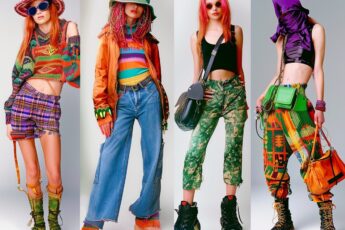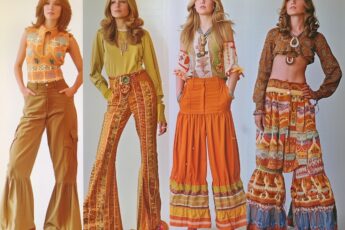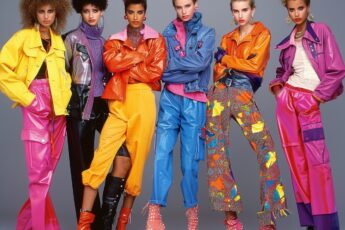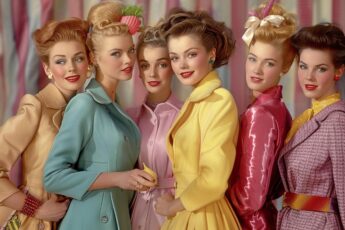The Surprising Journey of 1940s Fashion
The 1940s marked a pivotal era in fashion history. I’ve always been fascinated by how world events shape our clothing choices, and this decade exemplifies that relationship perfectly. World War II cast a long shadow over style, influencing everything from fabric availability to silhouette preferences.
As I delve into the fashion landscape of the 1940s, I’m struck by the resourcefulness and creativity that emerged from necessity. Rationing forced designers and everyday people to rethink their approach to clothing, leading to some truly innovative solutions.
The early years of the decade saw a shift towards utility and practicality. Unprecedented numbers of women entering the workforce needed functional outfits that could withstand manual labor. Yet, even in these constraints, style found a way to flourish.
Key elements of 1940s fashion include:
- Squared shoulders
- Knee-length skirts
- Victory rolls hairstyles
- Oxford shoes
- High-waisted trousers
As the war ended, fashion took a dramatic turn. The post-war era ushered in a new exuberance, epitomized by Christian Dior’s “New Look” in 1947. Suddenly, fabric restrictions gave way to voluminous skirts and nipped-in waists.
Throughout this article, I’ll explore how these trends evolved, their cultural significance, and their lasting impact on the fashion world. From utility clothing to Hollywood glamour, the 1940s offer a rich tapestry of style that continues to inspire designers today.
Fashion is not something that exists in dresses only. Fashion is in the sky, in the street; fashion has to do with ideas, the way we live, what is happening.
This quote encapsulates the essence of 1940s fashion – a reflection of the tumultuous times and the indomitable human spirit. Join me as we unravel the fascinating story of style in this transformative decade.
Wartime Restrictions on Clothing Production
The outbreak of World War II in 1939 dramatically altered the fashion landscape. Governments worldwide imposed strict rationing measures on clothing production to conserve resources for the war effort. This shift profoundly impacted both designers and consumers.
In my research, I’ve found that fabric restrictions were particularly influential. Wool and nylon, crucial for military uniforms, became scarce for civilian use. This scarcity pushed designers to get creative with alternative materials. They turned to rayon, a synthetic fabric, for many garments.
Government regulations also dictated design elements. For example:
- Skirt lengths were limited
- The number of pleats was restricted
- Pocket sizes were reduced
- Double-breasted jackets were banned
These rules aimed to minimize fabric use while maintaining functionality. As a result, clothing became more streamlined and practical.
I’ve always been impressed by how these restrictions sparked innovation. Designers found clever ways to create stylish garments within the limits. They used clever cutting techniques to maximize fabric efficiency and added decorative elements that didn’t require extra material.
Necessity is the mother of invention.
This old adage perfectly captures the spirit of 1940s wartime fashion. The industry’s ability to adapt and thrive under such constraints is truly remarkable.
Utility Clothing Scheme in Britain
I am fascinated by Britain’s response to wartime fashion needs. In 1941, the government introduced the Utility Clothing Scheme, a groundbreaking initiative that standardized clothing production.
Under this scheme, the Board of Trade established strict guidelines for garment manufacturing. These rules ensured that clothes were:
- Affordable
- Durable
- Of consistent quality
The most recognizable aspect of utility clothing was the CC41 label. CC stood for ‘Controlled Commodity,’ and 41 denoted the year the scheme began. This label became a symbol of patriotic consumption during the war years.
Key features of utility clothing included:
| Feature | Description |
|---|---|
| Silhouette | Slim, fabric-saving cuts |
| Colors | Limited palette, often muted |
| Detailing | Minimal, focusing on function |
| Fabric | Sturdy, long-lasting materials |
Despite its utilitarian nature, I find the clothing from this era surprisingly stylish. Designers like Hardy Amies and Norman Hartnell contributed to the scheme, proving that fashion could thrive even under strict regulations.
The Utility Scheme had a lasting impact on British fashion. It democratized style, making well-designed clothes accessible to all social classes. In my view, this initiative laid the groundwork for the ready-to-wear boom in the following decades.
True style never goes out of fashion.
This sentiment rings especially true for utility clothing. Its clean lines and functional elegance continue to inspire designers today, showing that sometimes, less really is more.
Make Do and Mend Movement
The Make Do and Mend campaign emerged as a pivotal response to wartime scarcity. This movement encouraged people to extend the life of their clothing through creative repairs and alterations. I find it fascinating how this necessity-driven approach shaped an entire generation’s relationship with fashion.
The British government distributed leaflets and posters with tips on clothing care and repair. These guides taught valuable skills such as:
- Darning socks
- Patching worn areas
- Turning collars to hide wear
- Repurposing adult clothes for children
Home sewing surged in popularity during this period. Women’s magazines featured patterns for transforming old garments into new styles. This DIY approach fostered a sense of pride in one’s appearance despite the limitations.
Key aspects of the Make Do and Mend ethos:
- Resourcefulness in using available materials
- Creativity in reimagining existing garments
- Skill development in clothing repair and construction
- Emphasis on quality over quantity
The impact of this movement extended beyond the war years. It instilled a lasting appreciation for craftsmanship and sustainability in fashion. Today, as we grapple with overconsumption, the Make Do and Mend philosophy offers valuable lessons.
In character, in manner, in style, in all things, the supreme excellence is simplicity.
This quote encapsulates the essence of 1940s fashion under the Make Do and Mend movement. Simplicity and ingenuity became the hallmarks of style.
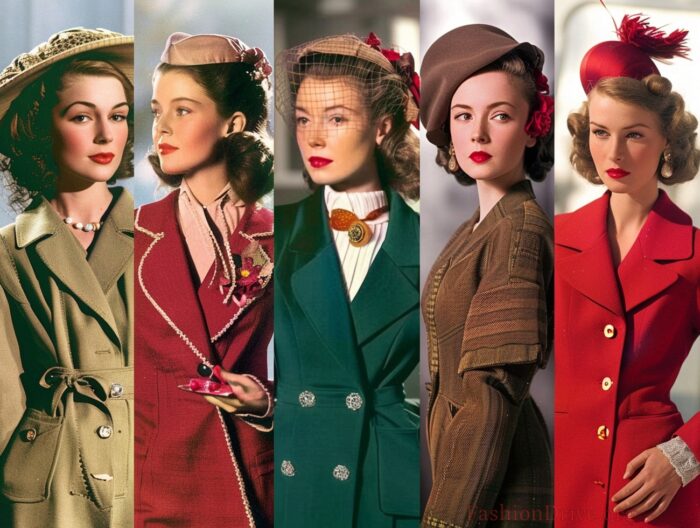
Women’s Workwear Evolution
The 1940s witnessed a revolutionary change in women’s workwear. As men left for war, women stepped into traditionally male-dominated industries. This shift demanded practical clothing that could withstand the rigors of factory work while maintaining femininity.
Rosie the Riveter, with her rolled-up sleeves and polka-dot bandana, became an iconic symbol of this transformation. Her image influenced workwear trends across the United States and beyond.
Key elements of 1940s women’s workwear included:
| Item | Description |
|---|---|
| Coveralls | One-piece garments for ease of movement |
| Trousers | Wide-legged for comfort and practicality |
| Sturdy shoes | Often with reinforced toes for safety |
| Head scarves | To keep hair away from machinery |
The acceptance of trousers for women marked a significant shift in fashion norms. While pants had previously been worn for leisure, their adoption for work paved the way for wider acceptance in everyday wear.
I’ve always admired how this era blended functionality with style. Despite the practical requirements, women found ways to express their individuality through accessories and hairstyles.
The impact of this workwear revolution extended far beyond the factory floor. It challenged traditional gender roles and influenced post-war fashion trends. The idea that women’s clothing could be both practical and stylish took hold, shaping design philosophies for decades to come.
Fashion is not necessarily about labels. It’s not about brands. It’s about something else that comes from within you.
This sentiment reflects the spirit of 1940s workwear. Women embraced a new aesthetic born of necessity, proving that true style transcends traditional fashion boundaries.
Military Influence on Civilian Attire
The 1940s saw an unprecedented blending of military and civilian fashion. As millions donned uniforms, their style inevitably seeped into everyday wear. This influence fascinates me, as it showcases how global events shape our sartorial choices.
Shoulder pads became a defining feature of 1940s fashion. Originally designed to create a more imposing silhouette for soldiers, they found their way into women’s jackets and dresses. This structured look symbolized strength and resilience during tough times.
Military-inspired elements in civilian clothing included:
- Epaulettes on jackets
- Brass buttons on coats
- Belted waists reminiscent of officer’s uniforms
- Pocket detailing on shirts and dresses
The color palette of civilian fashion also shifted. Khaki and olive drab, once exclusive to military gear, became popular choices for everyday wear. These earthy tones reflected the somber mood of wartime and the practical need for camouflage-inspired colors.
Style is a way to say who you are without having to speak.
This quote perfectly captures how 1940s fashion, infused with military influences, conveyed resilience and adaptability.
The military influence extended to accessories as well. Women often wore garrison caps tilted at a jaunty angle, mirroring the style of servicewomen. Men adopted the rugged appeal of combat boots for casual wear.
I find it remarkable how these military-inspired trends continued to influence fashion long after the war ended. The structured silhouettes and utilitarian details became staples of post-war style, paving the way for future trends.
Zoot Suit Subculture
Amidst the austerity of 1940s fashion, the Zoot Suit emerged as a bold statement of rebellion and cultural identity. This flamboyant style, popular among young African American and Latino men, stood in stark contrast to the conservative, military-inspired fashions of the day.
Key features of the Zoot Suit included:
| Element | Description |
|---|---|
| Jacket | Long, wide-shouldered, often reaching to the knees |
| Trousers | High-waisted, wide-legged, tapered at the ankles |
| Watch chain | Long, dangling from the belt to the knees |
| Hat | Wide-brimmed, often adorned with a feather |
The exaggerated silhouette of the Zoot Suit required large amounts of fabric, making it a controversial style during wartime rationing. This excess fabric became a symbol of defiance against mainstream fashion norms and societal expectations.
I’m particularly intrigued by the cultural significance of the Zoot Suit. It represented more than a fashion choice; it was a statement of identity for marginalized communities. The style became associated with jazz culture and a new sense of urban sophistication.
The Zoot Suit’s influence extended beyond clothing. It inspired a whole subculture, complete with its own slang, music preferences, and dance styles. This comprehensive lifestyle approach to fashion was ahead of its time.
Fashion is the armor to survive the reality of everyday life.
This quote resonates strongly with the Zoot Suit phenomenon. For its wearers, the suit provided a form of cultural armor in a society that often marginalized them.
Sadly, the Zoot Suit also became a target of racial tensions, culminating in the Zoot Suit Riots of 1943 in Los Angeles. Despite this, the style’s impact on fashion and popular culture endured, influencing future generations of designers and cultural movements.
The Zoot Suit remains a powerful reminder of fashion’s ability to challenge norms and express cultural identity, even in the face of societal pressure.
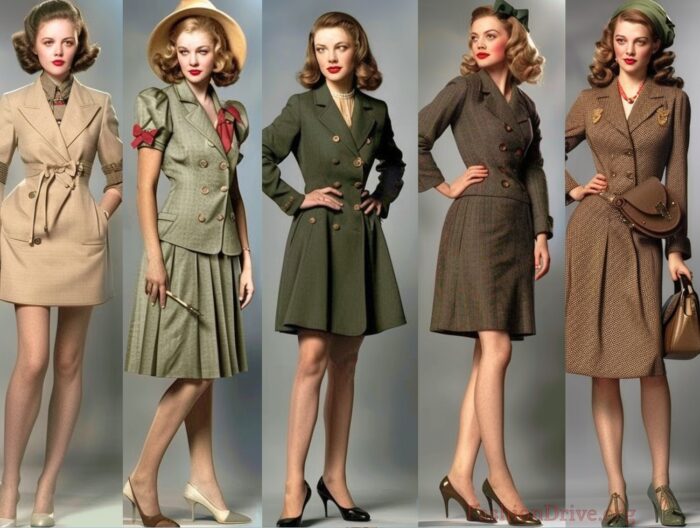
Hollywood’s Impact on 1940s Style
Hollywood’s influence on 1940s fashion cannot be overstated. Despite wartime restrictions, the silver screen continued to captivate audiences and shape style trends. I find it fascinating how cinema provided an escape from reality while simultaneously influencing everyday fashion choices.
The sweater girl look, popularized by actresses like Lana Turner and Jane Russell, became iconic. This style emphasized a curvaceous silhouette, often achieved through tight sweaters paired with bullet bras. It represented a blend of sensuality and the era’s focus on knitwear due to fabric rationing.
Key elements of Hollywood-inspired 1940s fashion:
- Padded shoulders for a strong silhouette
- Nipped-in waists to enhance curves
- Ankle-length skirts for elegance
- Peep-toe shoes for a touch of glamour
- Elaborate hairstyles, often featuring victory rolls
The influence of film noir on fashion was particularly striking. This genre’s moody aesthetics translated into sleek, sophisticated looks for both men and women. Trench coats, fedoras, and form-fitting dresses became staples of the film noir-inspired wardrobe.
Elegance is the only beauty that never fades.
This quote encapsulates the timeless appeal of 1940s Hollywood fashion. Even in times of austerity, the silver screen provided a glimpse of enduring style.
I’m always struck by how Hollywood managed to work within wartime restrictions while still creating memorable looks. Designers used clever techniques, such as sequin detailing on otherwise simple dresses, to create the illusion of luxury.
The impact of Hollywood fashion extended beyond clothing. Hairstyles and makeup trends popularized by movie stars were eagerly adopted by women worldwide, offering a touch of glamour in challenging times.
Swimwear Innovations
The 1940s marked a turning point in swimwear design, with innovations that continue to influence beach fashion today. I find the evolution of swimwear during this decade particularly intriguing, as it reflects changing social norms and technological advancements.
The emergence of the two-piece suit was a revolutionary development. While not as revealing as the modern bikini, these suits exposed the midriff for the first time, causing quite a stir. The design was partly influenced by wartime fabric rationing, but it also represented a new boldness in women’s fashion.
Key developments in 1940s swimwear:
| Innovation | Description |
|---|---|
| Two-piece suits | Separate top and bottom, exposing midriff |
| Higher waistlines | Covered navel, emphasizing hourglass figure |
| Built-in support | Bra cups integrated into swimsuit tops |
| New fabrics | Introduction of lastex and other stretchy materials |
The introduction of new fabric developments significantly improved the fit and functionality of swimwear. Materials like lastex, a yarn with rubber core, allowed for better stretch and recovery, enhancing both comfort and style.
Men’s swimwear also evolved during this period. Trunk-style shorts became popular, replacing the one-piece suits of earlier decades. These new styles offered greater freedom of movement and a more modern aesthetic.
Fashion is about dressing according to what’s fashionable. Style is more about being yourself.
This sentiment reflects the individualistic approach to swimwear that began to emerge in the 1940s. While still modest by today’s standards, these new styles allowed for greater personal expression.
I’m particularly impressed by how designers of the era balanced modesty with functionality and style. The high-waisted bottoms and supportive tops of women’s swimsuits created a flattering silhouette while still providing adequate coverage.
The innovations in 1940s swimwear laid the groundwork for the more revealing styles of the 1950s and beyond. This decade marked a crucial shift in attitudes towards beachwear, blending practicality with a new sense of freedom in fashion.
Accessories in Wartime
Accessories played a crucial role in 1940s fashion, allowing for personal expression within the constraints of wartime rationing. I’ve always been fascinated by how people used small details to make big-style statements during this era.
Turbans and headscarves gained immense popularity, serving both practical and fashionable purposes. Women working in factories needed to keep their hair out of machinery, while those dealing with infrequent washing due to water shortages found these accessories invaluable. The versatility of headscarves allowed for countless styling options, adding a pop of color to often drab wardrobes.
Key accessories of the 1940s included:
- Shoulder bags (hands-free for work)
- Brooches (to add flair to simple outfits)
- Gloves (both practical and elegant)
- Compact mirrors (for quick touch-ups)
- Gas mask cases (stylishly disguised as handbags)
The rise of costume jewelry marked another significant trend. With precious metals directed towards the war effort, designers turned to plastics, glass, and non-essential metals to create bold, affordable pieces. These statement accessories added glamour to utility clothing and homemade garments.
Style is knowing who you are, what you want to say, and not giving a damn.
This quote embodies the resourceful spirit of 1940s accessorizing. Despite limitations, people found creative ways to express their individuality.
I’m particularly impressed by how functionality and style merged in 1940s accessories. Gas mask cases designed to look like handbags exemplify this blend of necessity and fashion. It’s a powerful reminder of how fashion adapts to even the most challenging circumstances.
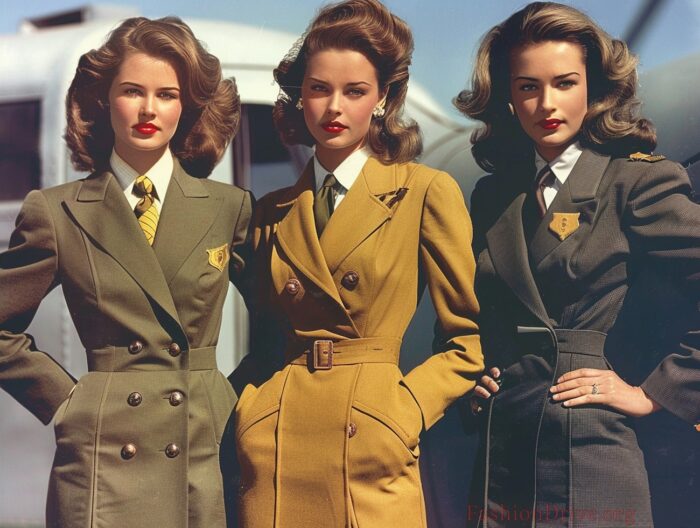
Footwear Adaptations
The 1940s saw significant changes in footwear design, driven by wartime shortages and changing fashion needs. I find the innovations of this period particularly intriguing, as they laid the groundwork for many modern shoe styles.
The introduction of the platform shoe was a game-changer. Designers used non-rationed materials like cork and wood for soles, creating height while adhering to material restrictions. These shoes often featured ankle straps for stability, adding a feminine touch to their sturdy construction.
Popular 1940s shoe styles included:
| Style | Description |
|---|---|
| Wedges | Comfortable, stable, often with fabric uppers |
| Oxfords | Practical lace-ups for work and casual wear |
| Peep-toes | Glamorous option for eveningwear |
| Sandals | Open designs to save on rationed leather |
The wedge heel gained significant popularity during this time. Its solid construction provided stability and comfort, making it ideal for women working long hours in factories. Designers got creative with materials, using everything from rope to wood to create these versatile shoes.
For men, the rugged appeal of military boots influenced civilian styles. Sturdy work boots and brogues became staples, reflecting the practical needs of the era.
Give a girl the right shoes, and she can conquer the world.
This sentiment captures the empowering nature of 1940s footwear. Despite material shortages, shoe designers created styles that were both functional and confidence-boosting.
I’m always impressed by the ingenuity displayed in 1940s shoe design. The use of alternative materials and innovative construction techniques allowed for style even in austerity. Many of these adaptations, like the platform sole and wedge heel, remain popular today, a testament to their enduring appeal and functionality.
The footwear of the 1940s perfectly encapsulates the era’s blend of practicality and style. It demonstrates how fashion can adapt to and overcome challenges, creating lasting trends in the process.
Men’s Suit Transformations
The 1940s brought significant changes to men’s suits, reflecting both the necessities of wartime and evolving fashion sensibilities. I find this era particularly fascinating for its blend of utility and style in menswear.
Wider shoulders became a hallmark of 1940s suits. This trend, influenced by military uniforms, created a V-shaped silhouette that exuded strength and masculinity. Jacket lengths shortened slightly, and the overall cut became more fitted, emphasizing a trim waistline.
Key features of 1940s men’s suits included:
- High-waisted trousers
- Pleated pants for ease of movement
- Single-breasted jackets (to conserve fabric)
- Minimal pocket flaps and cuffs
The war’s profound impact on suit design was fabric rationing, which led to the elimination of superfluous details. For instance, trouser cuff restrictions came into effect in many countries to save material. This seemingly small change altered the entire look of men’s pants.
Simplicity is the ultimate sophistication.
This quote perfectly captures the essence of 1940s men’s suiting. Despite restrictions, or perhaps because of them, suits from this era achieved a timeless elegance.
Color palettes for suits also shifted during this time:
| Color | Popularity |
|---|---|
| Navy | Very high |
| Dark brown | High |
| Charcoal gray | Increasing |
| Lighter hues | Reserved for summer |
I’m particularly intrigued by how these wartime suits influenced post-war fashion. The emphasis on a strong shoulder and trim waist persisted, shaping men’s fashion for decades to come.
Post-War New Look Revolution
The end of World War II ushered in a dramatic transformation in women’s fashion, epitomized by Christian Dior’s New Look. Introduced in 1947, this revolutionary style marked a radical departure from the utilitarian fashions of the war years.
Dior’s New Look featured:
- Nipped-in waists
- Full, voluminous skirts
- Soft shoulders
- Emphasized busts
This silhouette celebrated femininity and luxury after years of austerity. It required vast amounts of fabric, a stark contrast to wartime rationing. The New Look sparked controversy but ultimately prevailed, shaping fashion for the next decade.
The influence of the New Look extended beyond haute couture:
- Ready-to-wear manufacturers adapted the style for mass production
- Undergarments evolved to achieve the desired silhouette
- Accessory designs changed to complement the new proportions
- Hairstyles and makeup trends shifted to match the feminine aesthetic
Fashion fades, only style remains the same.
This sentiment reflects the lasting impact of the New Look. While specific designs changed, the emphasis on a feminine silhouette persisted.
I am particularly fascinated by the resurgence of full skirts. After years of straight, narrow cuts, the abundant fabric of circle skirts symbolized a return to prosperity and optimism.
I see the New Look as more than a fashion trend; it was a cultural reset. It represented a collective desire to move past the hardships of war and embrace a new era of peace and abundance. The rapid adoption of this style across social classes demonstrates fashion’s power to capture and express societal moods.

Teenage Fashion Emergence
The 1940s marked a pivotal moment in fashion history with the emergence of a distinct teenage style. This development fascinates me as it signaled a shift in social dynamics and consumer culture.
The Bobby soxer look epitomized the teenage fashion of the era. Young girls embraced a style that set them apart from both children and adults. Key elements of this look included:
- Knee-length skirts
- Sweaters or blouses
- Ankle socks (often white)
- Saddle shoes or loafers
This style represented a form of rebellion, albeit a mild one by today’s standards. It allowed teenagers to express their budding individuality while still adhering to social norms.
The acceptance of more casual wear for teenagers also took root in this decade. Jeans and T-shirts, originally workwear, began to gain popularity among young people for everyday attire.
Youth is the gift of nature, but age is a work of art.
This quote reflects the emerging recognition of youth as a distinct life stage with its own fashion sensibilities.
I find it particularly interesting how music and celebrity culture influenced teenage fashion:
| Influence | Fashion Impact |
|---|---|
| Frank Sinatra | Bow ties, fedoras for boys |
| Betty Grable | Pinup-inspired looks for girls |
| Swing music | Looser, movement-friendly clothing |
The rise of teenage fashion in the 1940s laid the groundwork for the youth-oriented culture that would explode in the following decades. It marked the beginning of teenagers as a distinct consumer group, forever changing the fashion industry.
Lingerie and Undergarments Developments
The 1940s saw significant developments in lingerie and undergarments, driven by changing fashion needs and material innovations. I find this aspect of 1940s fashion particularly intriguing as it reflects broader societal shifts.
The scarcity of nylon stockings during the war led to creative solutions. Women often used leg makeup or drew seams on the backs of their legs to create the illusion of stockings. This shortage had a lasting impact on fashion and led to the increased popularity of socks and bare legs.
Key undergarment trends of the 1940s included:
- Girdles for waist-cinching
- Long-line bras for torso smoothing
- Slips for modesty under sheer fabrics
- Garter belts for holding up stockings
The introduction of the bullet bra towards the end of the decade marked a significant shift in silhouette. This conical-shaped bra created a prominent, pointed bust that would define the look of the 1950s.
The most courageous act is still to think for yourself. Aloud.
This quote captures the subtle rebellion in women’s undergarment choices during this era as they navigated between traditional expectations and new fashion trends.
Innovations in undergarment design during the 1940s:
- Use of elastic for better fit and comfort
- Development of padded bras for enhancement
- Introduction of plastic boning as a lighter alternative to metal
I’m particularly fascinated by how these undergarment developments reflected and shaped outer fashion trends. The structured undergarments of the 1940s were essential in achieving the idealized silhouettes of the era, from the utilitarian shapes of wartime to the curvy New Look that followed.
The evolution of lingerie and undergarments in the 1940s set the stage for the foundation of garments that would define women’s fashion in the following decade, illustrating the crucial role of undergarments in fashion history.
Hairstyles and Makeup Trends
The 1940s saw a fascinating evolution in hairstyles and makeup, reflecting the era’s blend of practicality and glamour. I find this aspect of 1940s fashion particularly compelling, as it showcases how women maintained style even in challenging times.
Victory rolls became the quintessential 1940s hairstyle. These upswept curls, often worn at the front of the head, symbolized both patriotism and femininity. Women across social classes adopted this versatile style, which worked well with the era’s ubiquitous headscarves and hats.
Popular 1940s hairstyles included:
- Page boy (shoulder-length with curled ends)
- Pompadour (voluminous front, sleek sides)
- Pin curls (for achieving tight, lasting curls)
- Snoods (hair nets often worn for work)
Makeup trends of the 1940s emphasized a natural yet polished look. The significance of red lipstick during this period cannot be overstated. It became a symbol of resilience and patriotism, with cosmetic companies marketing shades like “Victory Red.”
Key elements of 1940s makeup:
| Feature | Description |
|---|---|
| Eyebrows | Natural, slightly arched |
| Eye shadow | Subtle, often in grey or brown |
| Mascara | Applied sparingly |
| Blush | Soft, rosy tones |
| Lipstick | Bold reds or deep pinks |
The best color in the whole world is the one that looks good on you.
This quote captures the individualistic approach to beauty that began to emerge in the 1940s despite the limited range of available products.
I’m particularly intrigued by how women maintained these beauty standards despite shortages. Beetroot juice was often substituted for lipstick, while tea leaves served as makeshift eye shadow. These ingenious solutions highlight the creativity and resilience of women during this era.
The hairstyles and makeup trends of the 1940s continue to inspire modern looks, a testament to their enduring appeal and versatility.
Conclusion
The fashion landscape of the 1940s presents a fascinating study of adaptation and resilience. From the austerity of wartime restrictions to the exuberance of post-war styles, this decade saw dramatic shifts in clothing design, accessories, and beauty standards.
Key takeaways from 1940s fashion:
- Utility and practicality influenced design
- Creativity flourished despite material shortages
- Hollywood continued to shape style trends
- Distinct teenage fashion emerged
- The New Look revolutionized women’s silhouettes
The enduring influence of 1940s fashion is evident in contemporary styles. Elements like:
- High-waisted trousers
- Red lipstick
- Platform shoes
- Utility jackets
All trace their roots to this transformative decade.
I’m particularly struck by how 1940s fashion reflected broader societal changes. The acceptance of women in trousers, the rise of ready-to-wear clothing, and the emergence of teenage style all signaled shifts in social norms that would define the latter half of the 20th century.
Fashion is not something that exists in dresses only. Fashion is in the sky, in the street, fashion has to do with ideas, the way we live, what is happening.
This quote encapsulates the essence of 1940s fashion – a reflection of its time, adapting to circumstances while pushing boundaries and setting trends that would influence generations to come.
The 1940s stand as a testament to fashion’s power to adapt, inspire, and reflect the human spirit, even in the most challenging times. It’s a decade that continues to fascinate and influence, reminding us of the integral role fashion plays in our cultural history.
